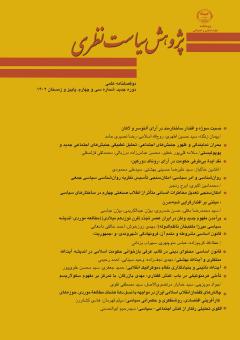قانون اساسی: محتوای دینی در قالب عرفی بازخوانی حکومت اسلامی در اندیشه آیتالله منتظری و آیتالله بهشتی
محورهای موضوعی : • Applying new theories and approaches
مهدی نجفزاده
1
![]() ,
وحید سینائی
2
,
وحید سینائی
2
![]() ,
احمد رحیمی
3
,
احمد رحیمی
3
1 - دانشیار گروه علوم سیاسی، دانشگاه فردوسی مشهد
2 - دانشیار علوم سیاسی دانشگاه فردوسي مشهد
3 - دانشجوی دکتری علوم سیاسی گرایش مسائل ایران، دانشگاه فردوسی مشهد
کلید واژه: قانون اساسی, ولایتفقیه, آیتالله منتظری, آیتالله بهشتی و اسکینر. ,
چکیده مقاله :
قانون اساسی جمهوری اسلامی ایران، آموزه ولایتفقیه را در کشور نهادینه و آن را بر تمام شئون مردم ایران چیره کرد. آیتالله حسینعلی منتظری و آیتالله سید محمد حسینی بهشتی به واسطه جایگاهشان در مجلس، نقشی بیبدیل در تدوین قانون اساسی داشتند. هر کدام از این دو درباره قانون اساسی و مفهوم آن در ذهنشان، تفاوتهای مهمی داشتند. در این مقاله از دیدگاه هرمنوتیک روشی اسکینر، به تحلیل نقش این دو شخصیت برجسته انقلاب اسلامی در قانون اساسی پرداختهایم. اینکه این دو از نظام سیاسی مستقر در قانون اساسی چه هدفی داشتند و عملاً چه کاری انجام دادند؟ آنها در دورانی که اسلام بهشدت از سوی اندیشه غربی، تهدید به نابودی میشد، میخواستند نظام سیاسی اسلامی ایجاد کنند. منتظری، مفاهیم و احکام فقه حول اندیشه ولایتفقیه را برای اداره جامعه اسلامی کافی میدانست؛ بهشتی اما احکام و موازین اسلامی را در حول محور ولایتفقیه به عنوان چارچوبی مینگریست که درون آن به گونهای گزینشی، مفاهیم مدرن دموکراتیک، مارکسیستی و حقوق بشری را بتوان استفاده کرد تا پاسخگوی جامعه کنونی ایران اسلامی باشد. در تحلیل نهایی در تدوین قانون اساسی، نظریه بهشتی دست بالا گرفت و حکومت اسلامی با ساختی عرفی را پدیدار کرد.
Constitutional Law: Reinterpretation
of the Islamic Government within the Framework
of Religious Content in the Jurisprudential Thoughts
of Ayatollah Montazeri and Ayatollah Beheshti
Mahdi Najafzadeh*
Vahid Sinaee**
Ahmad Rahimi***
The Constitution of the Islamic Republic of Iran institutionalized the principle of Guardianship of the Jurist (Velayat-e Faqih) in the country and extended its influence over all aspects of the lives of the Iranian people. Ayatollah Hussein-Ali Montazeri and Ayatollah Seyyed Mohammad Hosseini Beheshti played an irreplaceable role in formulating the Constitution due to their positions in the parliament. Each of these two eminent figures had significant differences in their understanding of the Constitution and its concepts. This article, from the perspective of Skinner's hermeneutic method, delves into analyzing the prominent roles of these two figures in the Islamic Revolution in the drafting of the Constitution. What were their intentions and practical actions within the political system established by the Constitution? During a time when Islam was severely threatened by Western thought, they aimed to establish an Islamic political system. Montazeri believed that the principles and rules of fiqh concerning the concept of Guardianship of the Jurist were sufficient for governing Islamic society, while Beheshti viewed Islamic principles and standards around the axis of Guardianship of the Jurist as a framework that could selectively incorporate modern democratic, Marxist, and human rights concepts to be responsive to the current Iranian Islamic society. In the final analysis, Beheshti's theory prevailed in drafting the Constitution, bringing about an Islamic government through a constructed customary process.
Keywords: Constitution, Velayat-e Faqih, Ayatollah Montazeri, Ayatollah Beheshti and Skinner.
* Corresponding Author: Associate Professor, Political Science Department, Ferdowsi University of Mashhad, Iran.
m.najafzadeh@um.ac.ir
** Associate Professor, Department of Political Science, Ferdowsi University of Mashhad, Iran.
sinaee@um.ac.ir
*** Ph.D. Student of political science majoring in Iranian issues, Ferdowsi University of Mashhad, Iran.
ahmadrahimi222@gmail.com
